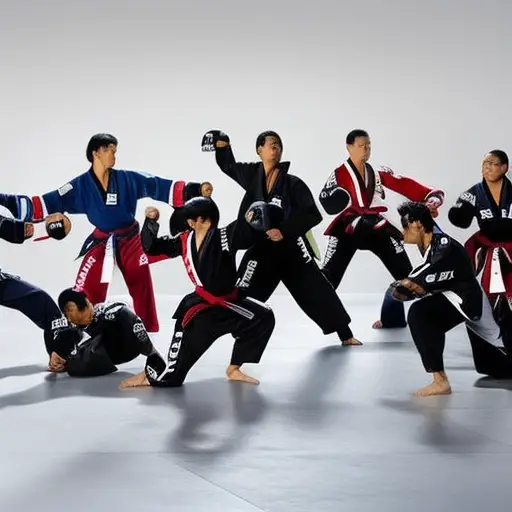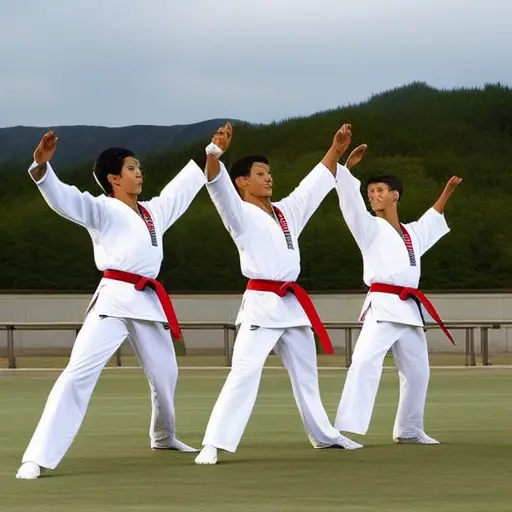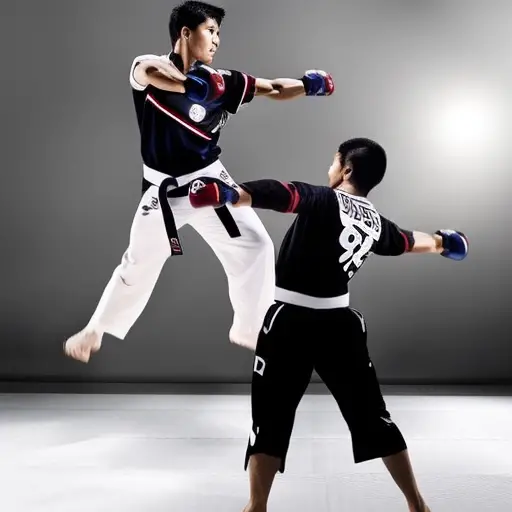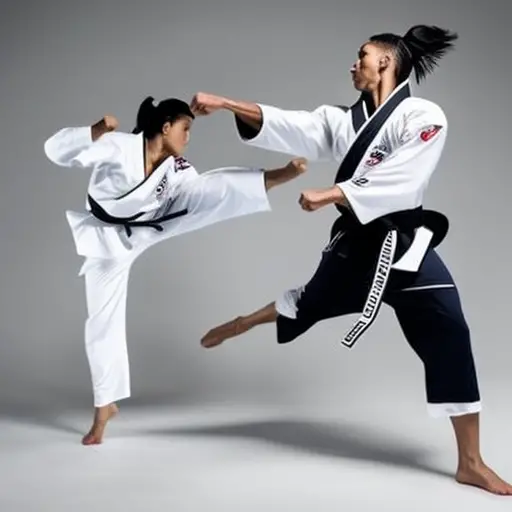Adaptive Taekwondo: Training for People With Disabilities

According to recent studies, approximately 15% of the global population lives with disabilities, facing unique challenges when it comes to physical activity and self-expression. This is where adaptive taekwondo comes in, offering a specialized training program tailored to individuals with disabilities.
In this article, we will explore the history, philosophy, and benefits of adaptive taekwondo, as well as the techniques and adaptations used to empower and enhance the lives of those with physical and sensory impairments. Discover how adaptive taekwondo is changing lives and promoting inclusivity in the martial arts community.
The History and Philosophy of Adaptive Taekwondo
In the realm of martial arts, the history and philosophy of adaptive Taekwondo can be traced back to its origins in South Korea. Over the years, this form of martial art has evolved and adapted to cater to individuals with disabilities, providing them with an empowering and inclusive platform to engage in physical activity and self-defense.
The history of adaptive Taekwondo dates back to the early 1950s when General Choi Hong Hi, the founder of Taekwondo, began developing the martial art as a means of self-defense and physical fitness. As the popularity of Taekwondo grew worldwide, practitioners recognized the need to make the art accessible to individuals with disabilities. This led to the evolution of adaptive Taekwondo, which takes into account the unique needs and abilities of each individual.
The philosophy of adaptive Taekwondo is rooted in the principles of respect, discipline, and perseverance. It emphasizes the belief that anyone, regardless of their physical abilities, can benefit from and excel in the practice of martial arts. By adapting techniques and training methods, adaptive Taekwondo instructors empower individuals with disabilities to build self-confidence, improve physical strength and coordination, and enhance their overall well-being.
Adaptive Taekwondo embraces the philosophy that martial arts should be inclusive and accessible to all. Through its history and evolution, it continues to inspire individuals with disabilities to overcome challenges and achieve personal growth, both on and off the mat.
Understanding Different Types of Disabilities in Taekwondo
There are several different types of disabilities that individuals may have when participating in Taekwondo, each requiring unique adaptations and modifications to ensure inclusive and effective training. It is important for instructors and practitioners to understand these disabilities in order to provide appropriate support and guidance.
Some of the common types of disabilities encountered in Taekwondo include:
-
Physical disabilities: These can range from mobility impairments to limb amputations. Training techniques may need to be modified to accommodate limited range of motion or balance issues.
-
Visual impairments: Individuals with visual impairments may require verbal cues or tactile guidance during training. Techniques can be adapted to rely more on auditory and kinesthetic cues.
-
Intellectual disabilities: Individuals with intellectual disabilities may require simplified instructions and additional repetition to grasp techniques. Patience and understanding are key when working with these individuals.
-
Neurological disabilities: Conditions such as cerebral palsy or multiple sclerosis can affect muscle control and coordination. Training techniques may need to be adjusted to accommodate tremors or muscle stiffness.
By understanding the specific needs and challenges associated with different types of disabilities, instructors can create a safe and inclusive environment for all participants. This will not only enhance their training experience but also promote their physical and mental well-being.
Now, let’s explore the benefits of adaptive taekwondo training.
The Benefits of Adaptive Taekwondo Training
Engaging in adaptive Taekwondo training can lead to a range of benefits for individuals with disabilities.
One of the key advantages is the improvement in physical abilities, as the training focuses on strength, flexibility, and coordination.
Additionally, adaptive Taekwondo can also enhance mental well-being by promoting self-confidence, discipline, and stress relief.
Improved Physical Abilities
The adaptive taekwondo training program has shown significant improvement in participants’ physical abilities. Through this program, individuals with disabilities have experienced enhanced balance and increased strength, leading to a range of benefits.
The training focuses on personalized exercises that target specific areas of weakness, allowing participants to build strength gradually and safely. The program utilizes a variety of techniques, including modified taekwondo movements and exercises that promote core stability and muscle strength.
The benefits of adaptive taekwondo training include improved balance, which helps individuals with disabilities navigate their daily lives more confidently. Additionally, the increased strength gained through the training program enables participants to perform everyday tasks with greater ease.
Enhanced Mental Well-Being
Many individuals with disabilities who participate in adaptive taekwondo training report a significant improvement in their overall mental well-being. The benefits of adaptive taekwondo extend beyond physical abilities, enhancing cognitive function and providing effective stress reduction techniques.
Engaging in regular training sessions helps to sharpen cognitive skills such as memory, attention, and problem-solving. The mental focus required during taekwondo practice stimulates neural connections and promotes improved cognitive function.
Additionally, adaptive taekwondo incorporates stress reduction techniques such as deep breathing and meditation, which can help individuals with disabilities manage their stress levels more effectively.
The combination of physical exercise, mental focus, and stress reduction techniques in adaptive taekwondo provides a holistic approach to improving mental well-being for people with disabilities. It empowers them to develop mental resilience, boost self-confidence, and find inner peace.
Techniques and Adaptations for Physical Disabilities
Individuals with physical disabilities can benefit from specific techniques and adaptations that are tailored to their unique needs and abilities. Adaptive Taekwondo offers a range of strategies and modifications that enable individuals with physical disabilities to actively participate in the sport. Here are some techniques and adaptations that can be used:
-
Adaptive Equipment: The use of adaptive equipment, such as prosthetics, wheelchairs, or braces, can help individuals with physical disabilities engage in Taekwondo. For example, prosthetic limbs can be modified to allow for better balance and stability during kicks, while wheelchairs can be equipped with specially designed attachments for performing strikes and blocks.
-
Modified Training Techniques: Taekwondo techniques can be adapted to accommodate different physical abilities. For individuals with limited mobility, modifications may include using modified stances or adjusting the range of motion required for certain kicks. Additionally, instructors can incorporate alternative training methods, such as seated or low-impact exercises, to ensure that individuals with physical disabilities can fully participate in training sessions.
-
Individualized Instruction: Each individual with a physical disability may have unique challenges and abilities. Therefore, it is crucial for instructors to provide personalized instruction and support. This may involve breaking down techniques into smaller, more manageable steps, offering additional assistance or modifications as needed, and providing encouragement and motivation throughout the training process.
-
Inclusive Environment: Creating an inclusive and supportive training environment is essential for individuals with physical disabilities. Instructors and fellow students can play a vital role by fostering a sense of belonging, respect, and understanding. This can be achieved through open communication, empathy, and recognizing and celebrating the achievements of all participants, regardless of their physical abilities.
Enhancing Sensory Awareness in Adaptive Taekwondo
Enhancing sensory awareness is a crucial aspect of adaptive Taekwondo training for individuals with disabilities. By incorporating sensory techniques such as visual cues, auditory prompts, and tactile feedback, practitioners can develop a deeper connection with their surroundings and improve their overall performance.
The benefits of sensory training not only include enhanced spatial awareness and reaction time but also increased self-confidence and empowerment for individuals with disabilities.
Incorporating Sensory Techniques
One key aspect of incorporating sensory techniques in adaptive Taekwondo is the use of targeted exercises to heighten sensory awareness. Sensory integration plays a crucial role in the overall development and well-being of individuals with disabilities. By incorporating sensory stimulation techniques, practitioners can enhance their sensory awareness and improve their overall performance in Taekwondo.
Here are some examples of how sensory techniques can be incorporated:
- Engaging in activities that stimulate different senses, such as using textured mats or playing music during training sessions.
- Incorporating proprioceptive exercises that focus on body awareness and spatial orientation.
- Utilizing visual aids, such as colored targets or visual cues, to enhance focus and attention.
- Implementing deep pressure techniques, such as weighted vests or compression wraps, to provide a calming effect and promote sensory regulation.
Benefits of Sensory Training
Multiple benefits arise from sensory training in adaptive Taekwondo. It enhances sensory awareness and improves the overall performance of practitioners.
Sensory integration and sensory processing are crucial elements in the practice of adaptive Taekwondo, especially for individuals with disabilities. Sensory training helps individuals become more attuned to their body and surroundings, allowing them to respond effectively to different stimuli.
By focusing on sensory awareness, practitioners can improve their balance, coordination, and reaction time. This not only enhances their performance in Taekwondo techniques but also translates into their daily lives, improving their overall motor skills and ability to navigate their environment.
Furthermore, sensory training in adaptive Taekwondo can help individuals with disabilities develop a stronger sense of body awareness and self-confidence. This empowers them to overcome challenges and achieve their full potential.
Mental Discipline and Cognitive Development in Taekwondo
Developing mental discipline and cognitive skills through the practice of Taekwondo can greatly benefit individuals of all abilities. Taekwondo is not just about physical strength and technique; it also requires mental focus and concentration. Here are some ways in which Taekwondo can enhance mental discipline and cognitive development:
-
Improved concentration: Taekwondo training involves performing complex patterns of movements, which require focus and concentration. Regular practice can enhance an individual’s ability to concentrate for extended periods of time.
-
Increased mental resilience: Taekwondo training pushes individuals to their limits, physically and mentally. This builds mental resilience and the ability to overcome challenges, both on and off the mat.
-
Enhanced problem-solving skills: Taekwondo involves analyzing opponents’ movements and strategizing in real-time. This cultivates quick thinking and problem-solving skills.
-
Boosted memory and cognitive function: Learning and remembering various techniques and patterns in Taekwondo can enhance memory and cognitive function.
By developing mental discipline and cognitive skills through Taekwondo, individuals can improve their overall cognitive abilities, including focus, concentration, resilience, problem-solving, and memory. These skills are not only valuable in the context of martial arts but also in everyday life. They can help individuals excel academically, professionally, and personally.
Transitioning into the subsequent section about ‘building confidence and self-esteem through adaptive taekwondo’, individuals who develop mental discipline and cognitive skills through Taekwondo also experience a positive impact on their self-confidence and self-esteem.
Building Confidence and Self-Esteem Through Adaptive Taekwondo
Enhancing self-assurance and self-worth through the practice of adaptive Taekwondo can have a transformative impact on individuals with disabilities. Building confidence and self-esteem are essential components of personal growth, and adaptive Taekwondo offers a unique platform for individuals to develop these qualities. By engaging in this martial art, individuals can build resilience and overcome challenges, both physical and mental, which in turn helps them develop a positive self-image.
Adaptive Taekwondo provides a supportive environment where individuals with disabilities can push their limits and discover their inner strength. Through consistent training and practice, they learn to break through barriers and achieve goals that they once thought were impossible. This process not only builds physical strength but also fosters mental fortitude, empowering individuals to face challenges head-on and develop a belief in their own abilities.
Moreover, the inclusive nature of adaptive Taekwondo creates a sense of belonging and community for individuals with disabilities. They find solace in knowing that they are not alone in their struggles and are surrounded by others who understand and support them. This support system further enhances their confidence and self-esteem, as they realize that they are valuable members of a larger community.
In the subsequent section, we will explore success stories that highlight how adaptive Taekwondo is changing lives. These stories demonstrate the profound impact this martial art has on individuals with disabilities, showcasing their personal growth, increased confidence, and improved self-esteem.
Success Stories: How Adaptive Taekwondo Is Changing Lives
Occasionally, adaptive Taekwondo has the power to profoundly change lives, as demonstrated by the inspiring success stories of individuals with disabilities. These stories showcase the transformative impact that adaptive Taekwondo has on both the participants and the community as a whole. Here are some success stories that highlight the incredible benefits of adaptive Taekwondo:
-
Improved Physical and Mental Health: Individuals with disabilities who engage in adaptive Taekwondo experience improved physical fitness and coordination. Moreover, the mental discipline and focus required in Taekwondo training help boost their confidence and self-esteem.
-
Enhanced Social Skills: Adaptive Taekwondo provides a supportive and inclusive environment where individuals with disabilities can interact with their peers. Through teamwork, respect, and camaraderie, participants develop valuable social skills and forge lasting friendships.
-
Increased Independence: Adaptive Taekwondo empowers individuals with disabilities to become more self-reliant and independent. By learning self-defense techniques and mastering Taekwondo forms, they gain a sense of empowerment and autonomy.
-
Inspiration and Role Models: Success stories in adaptive Taekwondo serve as a source of inspiration for others. These stories showcase the resilience, determination, and achievements of individuals with disabilities, challenging societal stereotypes and promoting inclusivity.
The impact of adaptive Taekwondo extends beyond the individuals involved. These success stories inspire and educate the broader community about the capabilities and potential of individuals with disabilities. They promote a more inclusive society and challenge preconceived notions about what is possible. Adaptive Taekwondo truly changes lives, one success story at a time.
Frequently Asked Questions
How Long Does It Take to Become Proficient in Adaptive Taekwondo?
The training duration for becoming proficient in adaptive taekwondo varies based on individual capabilities, commitment, and prior experience. However, the benefits of adaptive taekwondo, such as improved physical fitness and self-confidence, make the journey worthwhile.
Are There Any Age Restrictions for Participating in Adaptive Taekwondo?
Age restrictions in adaptive taekwondo are determined by eligibility requirements, ensuring the safety and well-being of participants. While there may be certain guidelines in place, the focus is on inclusivity and providing opportunities for individuals of all ages to engage in this empowering martial art.
Can Adaptive Taekwondo Be Practiced by Individuals With Visual Impairments?
Adaptive taekwondo techniques can be modified to accommodate individuals with visual impairments. Through training adaptations, such as auditory cues and tactile feedback, people with visual impairments can participate in and benefit from adaptive taekwondo.
Are There Any Competitions or Events Specifically for Adaptive Taekwondo Practitioners?
Adaptive taekwondo competitions play a crucial role in promoting inclusivity in martial arts. These events provide a platform for practitioners with disabilities to showcase their skills and talents, fostering a sense of empowerment and recognition within the community.
How Can Adaptive Taekwondo Contribute to Overall Physical Fitness and Strength?
Adaptive Taekwondo can significantly contribute to overall physical fitness and strength by improving flexibility, enhancing balance, and coordination. It offers a unique approach that empowers individuals with disabilities to achieve their fitness goals, promoting a sense of empowerment and well-being.
Conclusion
In conclusion, Adaptive Taekwondo is a powerful and transformative training method that has the potential to change the lives of individuals with disabilities. By understanding different types of disabilities and providing tailored techniques and adaptations, Adaptive Taekwondo enhances physical abilities and promotes sensory awareness.
Moreover, it fosters mental discipline, cognitive development, and builds confidence and self-esteem. Like a guiding light in a dark tunnel, Adaptive Taekwondo opens doors to endless possibilities and empowers individuals to reach their full potential.





